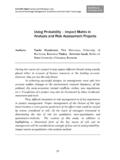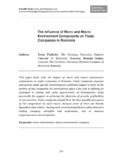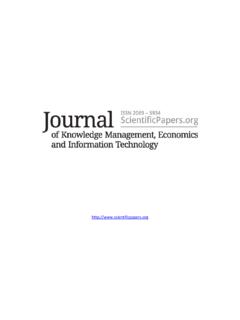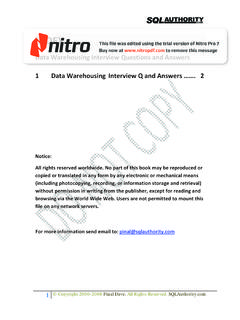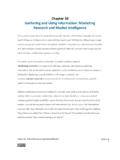Transcription of www.scientificpapers
1 Business intelligence Cebotarean Elena, Titu Maiorescu University, Romania Abstract Business intelligence (BI) refers to computer-based techniques used in spotting, digging-out, and analyzing business data , such as sales revenue by products and/or departments, or by associated costs and incomes. BI technologies provide historical, current, and predictive views of business operations. Common functions of business intelligence technologies are reporting, online analytical processing, analytics, data mining, business performance management, benchmarking, text mining, and predictive analytics. Business intelligence aims to support better business decision-making. Thus a BI system can be called a decision support system (DSS).
2 Though the term business intelligence is sometimes used as a synonym for competitive intelligence, because they both support decision making, BI uses technologies, processes, and applications to analyze mostly internal, structured data and business processes while competitive intelligence gathers, analyzes and disseminates information with a topical focus on company competitors. Business intelligence understood broadly can include the subset of competitive intelligence. Keywords: business intelligence, data , support system In a 1958 article, IBM researcher Hans Peter Luhn used the term business intelligence. He defined intelligence as: "the ability to apprehend the interrelationships of presented facts in such a way as to guide action towards a desired goal.
3 " Business intelligence as it is understood today is said to have evolved from the decision support systems which began in the 1960s and developed throughout the mid-80s. DSS originated in the computer-aided models created to assist with decision making and planning. From DSS, data warehouses, Executive Information Systems, OLAP and business intelligence came into focus beginning in the late 80s. In 1989 Howard Dresner (later a Gartner Group analyst) proposed "business intelligence" as an umbrella term to describe "concepts and methods to improve business decision making by using fact-based support systems." It was not until the late 1990s that this usage was widespread. Business intelligence and data warehousing Often BI applications use data gathered from a data warehouse or a data mart.
4 However, not all data warehouses are used for business intelligence, nor do all business intelligence applications require a data warehouse. In order to distinguish between concepts of business intelligence and data warehouses, Forrester Research often defines business intelligence in one of two ways: Typically, Forrester uses the following broad definition: "Business Intelligence is a set of methodologies, processes, architectures, and technologies that transform raw data into meaningful and useful information used to enable more effective strategic, tactical, and operational insights and decision-making." When using this definition, business intelligence also includes technologies such as data integration, data quality, data warehousing, master data management, text and content analytics, and many others that the market sometimes lumps into the Information Management segment.
5 Therefore, Forrester refers to data preparation and data usage as two separate, but closely linked segments of the business intelligence architectural stack. Forrester defines the latter, narrower business intelligence market as "referring to just the top layers of the BI architectural stack such as reporting, analytics and dashboards." Business intelligence and business analytics Thomas Davenport has argued that business intelligence should be divided into querying, reporting, OLAP, an "alerts" tool, and business analytics. In this definition, business analytics is the subset of BI based on statistics, prediction, and optimization. Applications in an enterprise Business Intelligence can be applied to the following business purposes (MARCKM), in order to drive business value.
6 1. Measurement program that creates a hierarchy of Performance metrics (see also Metrics Reference Model) and Benchmarking that informs business leaders about progress towards business goals (AKA Business process management). 2. Analytics program that builds quantitative processes for a business to arrive at optimal decisions and to perform Business Knowledge Discovery. Frequently involves: data mining, statistical analysis, Predictive analytics, Predictive modeling, Business process modeling 3. Reporting/Enterprise Reporting program that builds infrastructure for Strategic Reporting to serve the Strategic management of a business, NOT Operational Reporting. Frequently involves: data visualization, Executive information system, OLAP 4.
7 Collaboration/Collaboration platform program that gets different areas (both inside and outside the business) to work together through data sharing and Electronic data Interchange. 5. Knowledge Management program to make the company data driven through strategies and practices to identify, create, represent, distribute, and enable adoption of insights and experiences that are true business knowledge. Knowledge Management leads to Learning Management and Regulatory compliance/Compliance Business Intelligence Requirements Gathering According to Kimball business users and their requirements impact nearly every decision made throughout the design and implementation of a DW/BI system. The business requirements sit at the center of the business core, and are related to all aspects of the daily business processes.
8 They are therefore extremely critical to successful data warehousing. Business requirements analysis occurs at two distinct levels: Macro level: understand the business s needs and priorities relative to a program perspective Micro level: understand the users needs and desires in the context of a single, relatively narrowly defined project. Approach There are two basic interactive techniques for gathering requirements: 1. Conduct interviews. You need to talk to the users about their jobs, their objectives, and their challenges. This is either done with individuals or small groups 1. Facilitated sessions Can be used to encourage creative brainstorming Methods to avoid: Non-interactive alternatives such as sending out surveys and questionnaires is not an effective requirements gathering technique!
9 Preparation Identify the interview team Lead interviewer directing the questioning Scribe take copious notes during the interview A tape recorder may be used to supplement the scribe, since it is useful as a backup Observers optional part of the team. A good possibility for other team members to gain knowledge about interviewing techniques. It is advisable that there is no more than two observers present. Research the organization Reports, review of business operations, part of the annual report to gain insight regarding organizational structure. If applicable, a copy of the resulting documentation from the latest internal business/ IT strategy and planning meeting. Select the interviewees Select a cross section of representatives.
10 Study the organization to get a good idea of all the stakeholders in the project. These include: Business interviewees (to understand the key business processes) IT and Compliance/Security Interviewees (to assess preliminary feasibility of the underlying operational source systems to support the requirements emerging from the business side of the house. Develop the interview questionnaires Multiple questionnaires should be developed because the questioning will vary by job function and level. The questionnaires for the data audit sessions will differ from business requirements questionnaires Be structured. This will help the interview flow and help organize your thoughts before the interview. Schedule and sequence the interviews Scheduling and rescheduling takes time, so make sure you prepare these a good time in advance!)

